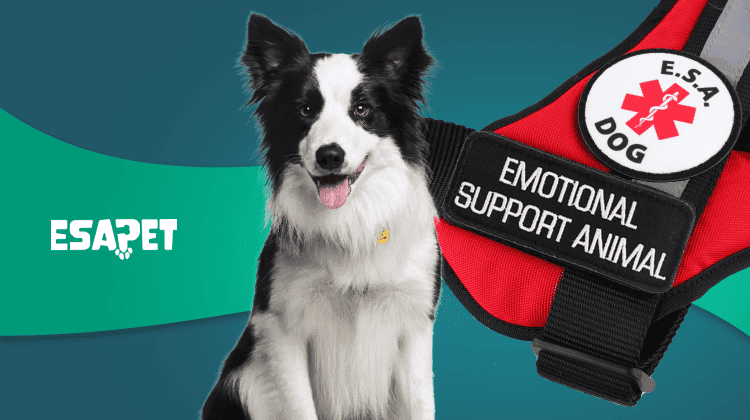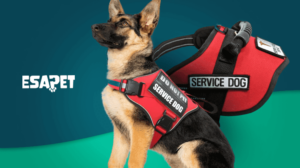Emotional Support Animal: What to Know Before You Get One

Emotional Support Animals play an essential role in mental health support. They provide comfort to people dealing with emotional or psychological challenges. This article will explain the benefits of having an ESA, how to get one, and the differences between ESAs and service animals.
What Are Emotional Support Animals (ESAs)?
An ESA is a pet that provides comfort and emotional support to individuals with a mental or emotional disability. Unlike service animals, ESAs don’t need special training to perform tasks. They help their owners by offering companionship.
Emotional support animals don’t need special training, unlike service animals, whose role is more specific. They simply offer companionship. Their presence can make life easier for people dealing with emotional difficulties. This bond brings a sense of stability and calm.
Animals That Qualify as Emotional Support Animals
Many animals can be emotional support animals. They offer comfort and support to those with emotional challenges. These animals must be well-behaved and provide a calming presence.
The only requirement is that it is a domesticated animal capable of offering emotional relief. Let’s explore both common and unique options for emotional support animals.
 |
Dogs Emotional support dogs are the most popular choice. Their loyalty and companionship are great. They easily bond with their owners, offering comfort during hard times. |
 |
Cats Emotional Support Cats are a great option for people who prefer a more independent companion. Their calm nature can provide emotional relief, and they are known for reducing stress and creating a peaceful environment. |
 |
Birds Birds, especially parrots, can also be ESAs. They offer companionship and are known to be engaging. Their playful behavior can lift spirits and create a joyful atmosphere. |
 |
Miniature Horses Miniature horses are less common but effective ESAs. They are gentle and supportive. Their larger size can offer a unique sense of comfort. It’s best for those needing more physical presence. |
 |
Pigs Pigs can also serve as ESAs. They are intelligent and affectionate animals. Pigs bond deeply with their owners and are known for their calm, comforting demeanor. Their unique nature can provide strong emotional support. |
 |
Reptiles and Amphibians Reptiles such as snakes, lizards, and turtles can be ESAs for individuals who find comfort in their quiet presence. Amphibians, like frogs, also provide a calming influence through their simplicity and routine care. |
 |
Small Mammals Small mammals, such as rabbits, ferrets, guinea pigs, and hamsters, make excellent ESAs. They are low-maintenance, gentle creatures. Their playful behavior and small size can provide comfort without requiring too much space. |
 |
Fishes Fish are unconventional but effective ESAs for some individuals. Watching them swim can have a calming effect, reducing anxiety and stress. They are also low-maintenance and easy to care for, making them ideal for those with limited space or time. |
 |
Insects Insects like certain beetles or butterflies can serve as ESAs, though this option is rare. For those who enjoy observing nature, insects can offer a sense of connection and calm through their quiet, delicate presence. |
 |
Unconventional ESA Species Unconventional species, like goats or chickens, can also be ESAs. Although these animals may not be traditional choices, they offer emotional support through companionship and unique personalities. |
What Disabilities Qualify Someone for an ESA?
Several mental health disabilities can qualify a person for an ESA. These include anxiety disorders, depression, post-traumatic stress disorder (PTSD), and panic disorders. People with these conditions struggle with intense feelings of fear, isolation, or sadness.
Other qualifying conditions include bipolar disorder, certain phobias, and mood disorders. Individuals with a mental disability that impacts daily functioning may benefit from an ESA. The goal is to reduce emotional stress and provide stability.
Key Benefits of Having an Emotional Support Animal
Research has shown that ESAs can offer significant mental health benefits. They are beneficial for individuals dealing with chronic mental illness. A study from the University of Toledo found that ESAs help reduce symptoms through consistent companionship.
Participants in the study showed improved emotional well-being. The study showed notable increases in oxytocin (the bonding hormone) and reductions in cortisol (a stress hormone). These findings support the idea that Tan ESA can enhance mental and emotional stability.
Beyond the emotional benefits, ESAs also provide a sense of purpose and responsibility. This can be crucial for individuals feeling isolated or disconnected. The consistent bond between a handler and their ESA encourages engagement in daily activities.
Housing Protections Under the Fair Housing Act
The Fair Housing Act applies to ESA owners, offering important protections. It allows individuals to live with their ESA in housing that may otherwise restrict pets. This includes apartments, condos, and houses with no-pet policies.
Having proper documentation ensures you can live with your ESA without issue. The Fair Housing Act waives pet fees for ESA owners. You won’t have to pay extra charges for your pet. These protections make it easier for people to keep their ESAs without worrying about added costs.
Important Facts to Know Before Getting an ESA
Before getting an ESA, it’s important to understand the responsibilities. ESAs need regular care and attention. You’ll need to provide your animal with food, exercise, and medical care. This commitment is crucial to ensure the animal’s well-being.
You must also consider the legal aspects of owning an ESA. You need an ESA letter from a licensed mental health professional for legal protection. This letter confirms your need for an ESA due to a diagnosed condition. Without it, your ESA won’t have the same legal recognition.
How to Get an Emotional Support Animal
The first step to getting an ESA is to consult a licensed mental health professional. They will test your condition to determine whether an ESA suits you. This consultation is crucial as it ensures that you genuinely need the emotional support an ESA provides.
Once diagnosed, you’ll need to obtain an official ESA letter. This letter must come from your mental health professional. It will serve as proof of your need for the animal. With this letter, you can enjoy the legal protections of owning an ESA.
Local ESA Regulations & How They Vary
Local regulations for ESAs can differ greatly from one place to another. Some areas may have stricter rules or extra requirements. Researching federal and local laws on emotional support animals is essential before relocating with your animal.
Understanding these laws helps you avoid complications. While federal laws like the Fair Housing Act protect you, local rules may still apply. Being informed will ensure a smoother experience when moving or traveling with your ESA.
What Is ESA Certification and Why Is It Important?
There is no official government Emotional Support Animal certification. However, a legitimate ESA letter is crucial for legal protection. This letter proves your need for emotional support from your ESA. It’s necessary for housing laws. Always ensure your ESA letter is from a licensed professional.
ESA Registration: Is It Legit?
ESA registration can be misleading. There is no legal need to register your ESA. Many websites offer to “register” your ESA, but this is unnecessary. The most important document is the ESA letter from an LMHP. It offers far more legal protection than any registration service.
Who Can Write an Emotional Support Animal Letter?
Only licensed mental health professionals can issue a valid ESA letter. This includes therapists, psychologists, and psychiatrists. They will assess your condition and determine if you qualify for an ESA. Without a professional evaluation, your letter won’t hold legal weight.
Learn More about Who Can Write an ESA Letter
What Information Must an ESA Letter Include?
An ESA letter must include specific details to show that you qualify for an emotional support animal. This information helps ensure the letter meets legal standards. Here’s what every valid ESA letter should contain:
- The mental health professional’s contact information
- A statement about the patient’s mental health condition
- An explanation of how the animal helps with the condition
- Confirmation that the patient needs the ESA for emotional support
Example of a Proper ESA Letter
A proper ESA letter must be clear, thorough, and provided by a licensed mental health professional. It should meet specific legal requirements to ensure its validity. Below are the key elements that every ESA letter should include:
- Mental Health Professional’s Information
The letter should begin with the professional’s name, credentials, and contact information. This includes their license number, address, and phone number. This information confirms the legitimacy of the document. - Patient’s Diagnosis
It should mention the patient’s mental health condition. This could be anxiety, depression, or any other qualifying issue. The letter doesn’t need to be detailed, but it should confirm the diagnosis. - Role of the ESA
The letter must explain how the emotional support animal helps the patient’s mental health. It should state that the animal provides necessary emotional support. This section shows why the ESA is essential to the patient’s well-being. - Confirmation of ESA Necessity
The letter should affirm that the patient requires the ESA for emotional stability. This part ensures legal protection under housing and travel laws. Without this statement, your ESA may not be recognized legally. Make sure this section is clear and direct.
Emotional Support Animals vs. Service Animals
ESAs and service animals serve different purposes. ESAs provide comfort and emotional support. They help people with mental or emotional conditions but don’t need special training. Their role is to improve emotional well-being through companionship alone.
Service animals are trained to perform specific tasks. These tasks assist individuals with physical or mental disabilities. For example, a service dog may help people navigate or alert them to medical emergencies. Service animals must undergo rigorous training to meet these needs.
Laws Governing Emotional Support Animals and Service Animals
ESAs and service animals both have legal protections, but the rules differ. Service animals have broader rights under federal law, while ESAs have more limited access. Knowing these laws helps you understand your rights and how they apply to your situation.
Several laws govern the rights of ESAs and service animals, each with its own rules. The FHA covers both types of animals, while the ADA applies to service animals. The ACAA had allowed ESAs to fly, but recent changes now give airlines more control over their policies.
- Fair Housing Act (FHA)
The Fair Housing Act (FHA) covers both an ESA and a service animal. It allows people to live with their animals without pet fees, even in no-pet housing. ESAs need a valid letter from an LMHP, whereas service animals are automatically covered. - Americans with Disabilities Act (ADA)
The Americans with Disabilities Act (ADA) only applies to service animals. This law allows service animals to go with their owners to public places, such as restaurants. ESAs do not have the same access and are not permitted in public spaces unless the establishment allows them. - Air Carrier Access Act (ACAA)
The Air Carrier Access Act (ACAA) has recently changed on ESAs. Before these changes, ESAs could travel in the cabin for free like service animals. Due to these changes, ESAs are no longer classified as service animals. This means ESAs may not receive travel benefits, unlike service animals.
Public Access and Travel Rights for Emotional Support Animals
ESAs have limited access to public spaces. Unlike service animals, ESAs are not automatically allowed in restaurants or other public areas. The specific policies of each business determine access. You must check the rules of places you plan to visit with your ESA.
For travel, ESAs have faced changes in recent years. Airlines no longer allow ESAs to fly in the cabin for free. While some may still permit ESAs, others have imposed restrictions. Each airline sets its own policy, so checking ahead is important before flying.
Service Dogs for Emotional Support (Psychiatric Service Dogs)
Psychiatric Service Dogs (PSDs) provide essential support to people with psychiatric conditions. These dogs are trained to perform tasks that help manage a person’s disability. For example, a PSD can interrupt anxiety episodes or provide grounding during panic attacks.
Unlike Emotional Support Dogs, PSDs have full public access rights. They can go with their owners into places where ESAs are not allowed. PSDs play a critical role in helping individuals with psychiatric disabilities navigate daily life more comfortably.
PSD Letters: Legal Documentation for Psychiatric Service Dogs
A psychiatric service dog requires proper legal documentation. This includes a PSD letter issued by an LMHP. The letter confirms that the person has a mental condition and needs the dog to perform tasks. This documentation grants the assistance animal legal recognition and access to public places.
Emotional Support Animals vs. Psychiatric Service Dogs
While both ESAs and PSDs provide comfort, their key differences exist. Psychiatric Service Dogs are trained to perform tasks to help people with mental health conditions. However, ESAs offer general emotional support without specific training.
PSDs also have more legal rights than ESAs, including public access to places and travel accommodations under certain laws. Understanding these differences can help you decide which type of support animal best meets your needs.
- Public Access Rights
Under federal law, psychiatric service dogs have full public access rights. They can accompany their owners to places like restaurants, stores, and public transportation. ESAs don’t have the same rights. Their access depends on business policies and state laws. - Travel Accommodations
Under federal law, PSDs are treated like other assistance animals. They can fly in the cabin with their owner with no extra fees. ESAs do not have these rights. Airlines have restricted ESA travel under the ACAA. Always check airline policies before traveling with an ESA.
Emotional Support Animals vs. Therapy Animals
ESAs work one-on-one with their owners, helping reduce anxiety, depression, and other emotional challenges. Their main purpose is to be a source of personal comfort for someone dealing with emotional difficulties.
Therapy animals are trained to work in group settings. They visit hospitals, schools, or care centers to provide therapeutic support to many people. Therapy animals don’t assist with specific tasks. Their role is to comfort groups of people and improve well-being during visits.
How to Request Accommodations for Your ESA
Requesting accommodations for your ESA can seem overwhelming, but it’s straightforward. Follow these steps to ensure you receive the accommodations you need:
- Get a Legitimate ESA Letter: Obtain a letter from a licensed mental health professional. This letter must confirm that you have a diagnosed mental condition. It should also state that your ESA is necessary for emotional support. The letter is essential for asserting your legal rights.
- Inform Your Landlord Early: Notify your housing provider as soon as possible. It’s best to give them time to review your request. Provide your ESA letter and explain your need for reasonable accommodations. Being upfront helps ensure a smoother process.
- Submit Your ESA Letter in Writing: Always submit your ESA letter in writing. This creates a paper trail of your request. Include a polite letter outlining your rights under the FHA. Be clear that you are requesting accommodations for your ESA.
- Expect Reasonable Requests for Documentation: Your landlord may request documentation. Be prepared to provide your ESA letter and any other relevant information. However, they cannot demand details about your condition.
- Know Your Legal Rights: Under the FHA, landlords cannot charge pet fees for ESAs. They also cannot deny your request solely because of a no-pet policy. If your request is reasonable, you are entitled to accommodations for your ESA.
Get your Official ESA Letter Consultation from a licensed therapist.
Get ESA Letter Now
Frequently Asked Questions About Emotional Support Animals
What Is an Emotional Support Animal?
An emotional support animal provides comfort and companionship. They help individuals dealing with mental or emotional disabilities. Unlike service animals, ESAs do not need special training. Their main purpose is to improve emotional well-being through their presence.
What Mental Illnesses Qualify for ESA?
Several mental health conditions can qualify for an ESA. These include anxiety, depression, post-traumatic stress disorder (PTSD), and bipolar disorder. Anyone with a mental health condition affecting daily life may benefit from an ESA.
Can My Dog Be an ESA?
Yes. Your dog can be an ESA if it provides emotional support. You’ll need a letter from a licensed mental health professional to certify the need. There’s no specific breed requirement. Any dog that brings comfort and reduces emotional stress can qualify as an ESA.
Can a Landlord Deny an Emotional Support Animal?
No. In most cases, a landlord cannot deny a legitimate ESA request. The Fair Housing Act protects your right to live with your ESA, even in no-pet housing. However, landlords can deny the request if the animal poses a threat or causes damage. Always provide proper documentation.
What’s the Difference Between an ESA and a Service Animal?
The main difference is the level of training. A service animal performs specific tasks for people with disabilities, while ESAs provide comfort but do not need special training. A service animal has broader public access rights, while ESAs have protections under housing laws.
Conclusion
Emotional support animals benefit those dealing with emotional or mental challenges. They provide comfort, reduce anxiety, and help individuals feel secure. ESAs are protected by laws like the FHA, ensuring your right to live with them, even in housing that restricts pets.
To get an ESA, you’ll need a letter from a licensed professional. This letter confirms your need for the animal and grants you legal protection. It’s important to consult a professional to determine if you qualify and follow the correct steps to obtain the letter.
Understanding the differences between emotional support animals and service animals is also crucial. While both provide support, service animals undergo special training to perform specific tasks. If an ESA could benefit you, explore your options and know your rights.






